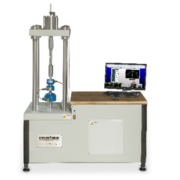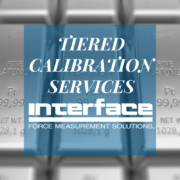Shunt Calibration 101
 Calibration is a critical stage to ensure proper accuracy and reliability of any force measurement device. There are many ways to calibrate and different types of calibration. In the standards of maintaining our quality and precision requirements, Interface calibrates every test measurement device we manufacture including our load cells and torque transducers. Every device is shipped with the most detailed calibration certifications in the industry.
Calibration is a critical stage to ensure proper accuracy and reliability of any force measurement device. There are many ways to calibrate and different types of calibration. In the standards of maintaining our quality and precision requirements, Interface calibrates every test measurement device we manufacture including our load cells and torque transducers. Every device is shipped with the most detailed calibration certifications in the industry.
With our experience and expertise, we understand that sharing what we know is beneficial to our customers and partners in the test and measurement industry. One of the means by which we do this is through a series of technical white papers. A popular white paper that was written years ago still stands the test of time, as it provides a deep dive on the topic of shunt calibration. Click on the title “Shunt Calibration for Dummies,” to access the full white paper.
What is Shunt Calibration?
Shunt calibration is a technique for simulating strain in a piezo-resistive strain gage Wheatstone bridge circuit by shunting one leg of the bridge. The bridge may be internal to a discreet transducer or composed of separately applied strain gages. The resulting bridge output is useful for calibrating or scaling instrumentation. Such instrumentation includes digital indicators, amplifiers, signal conditioners, A/D converters, PLC’s, and data acquisition equipment. Care must be taken to understand the circuits and connections, including extension cables, in order to avoid measurement errors.
Benefits of Shunt Calibration
The biggest reason to use shunt calibration is the flexibility and low-cost it offers the user. In this method of calibration, the bridge circuit is already there, and you don’t need to make and break cable connections to run it. This means that a shunt calibration can be applied conveniently and at any time during the test program. It is often used in situations where the user is calibrating control system equipment that will be communicating with a transducer or to confirm that the transducer is functioning properly.
Expected Shunt Calibration Repeatability in Modern Transducers
An important question that comes up regarding calibration is what type of repeatability can I expect from shunt calibration? Included below are the specifications outlining expected repeatability:
Procedure for a repeatability test performed:
- 100 Klbf Load Cell specimen loaded in compression.
- 12 test cycles of 4 mV/V hydraulically applied physical load and 1 mV/V Shunt Cal on two bridge legs.
- Rb = 350 ohm, Rs = 88750 ohm, 20 ppm/°C, internal to load cell.
- Measurements over 3 days.
- Interface Gold Standard HRBSC instrumentation.
Results of test
- Std Dev of physical load measurement: 0.004%.
- Std Dev of Shunt Cal: 0.001% pos, 0.001% neg.
The topics that are illustrated in examples and discussion points for this white paper include:
- Basic Bridge Circuit and Formulas
- Resistor Examples
- Tolerance
- Cables
- Errors
- Permanent Zero Balance Shifts
- Transducer Toggles
- Instrumentation
- Procedures for Repeatability in Tests
If this is a topic that of interest, download this technical reference guide for further exploration and calculation examples in shunt calibration.
As a leader in calibration services, Interface has an A2LA ISO 17025 accredited calibration lab located at the company’s headquarters in Arizona. Many depend on Interface for expert recalibration, which we recommend to do annually for optima maintenance. Our own calibration lab has the broadest capability and highest quality of calibration and repair services available. We understand the criticality of proper calibration and traceability and have the experience and expertise necessary to meet your exacting needs.
Additional Calibration Resources
Extending Transducer Calibration Range by Extrapolation
Additional Interface Calibration Grade Solutions
Gold Standard® Calibration System
This refreshed white paper is a tribute to the contributions of LaVar Clegg.









